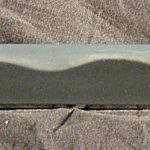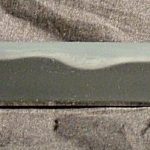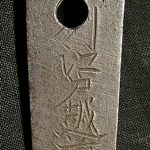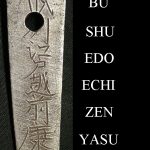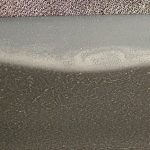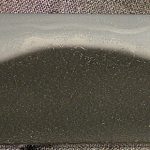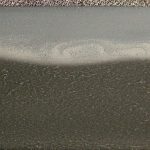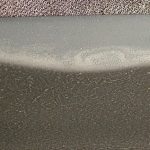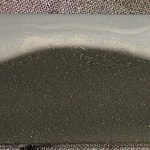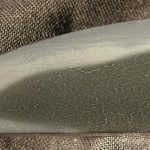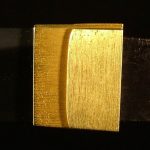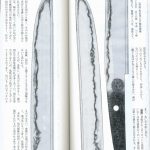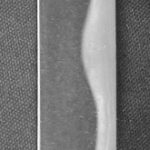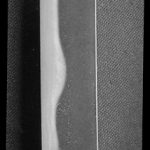YASUTSUGU / SHODAI / TANTO
ECHIZEN YASUTSUGU
SHODAI
Courtesy of Seskos:
YASUTSUGU (康継), 1st gen., Keichō (慶長, 1596-1615), Echizen/Musashi – “Higo no Daijō Fujiwara Shimosaka –Echizen-jū” (肥後大掾 藤原下坂・越前住), “Bushū Edo ni oite Echizen Shimosaka” (於武州江戸越前下坂), “Higo no Daijō Fujiwara Echizen Yasutsugu” (肥後大掾藤原越前康継), “Higo no Daijō Echizen Yasutsugu” (肥後大掾 越前康継), “Nanban-tetsu o motte Sunshū ni oite Echizen Yasutsugu” (以南蛮鉄於駿州越前康継, “made by Echizen Yasutsugu in Suruga province by using nanban-tetsu”), “Nanban-tetsu o motte Bushū Edo ni oite Echizen Yasutsugu” (以南蛮鉄於武州江戸越前康継, “made by Echizen Yasutsugu in Edo in Musashi province by using nanban-tetsu”), “Echizen no Kuni-jū Yasutsugu” (越前国住康継), real name Shimosaka Ichinojō (下坂市之丞), he also bore the first name Ichizaemon (市左衛門), a theory says that he was the Shimosaka smith from Ōmi province who is said to have been the son of Akasaka-Senju’in Hironaga (広長), but Hironaga bore the first name Hachirōzaemon (八郎左衛門) so it is unclear if they were really the same smiths, he received the honorary title Higo no Daijō during the Bunroku era (文禄, 1592-1596) and moved in the early years of the Keichō era to Ichijōdani (一乗谷) in Echizen province, later he moved to Echizen´s Kita no Shō (北ノ庄), the later Fukui (福井), he enjoyed the patronage of Honda Hida no Kami Narishige (本多飛騨守成重, 1572-1647), the daimyō of Echizen´s Maruoka fief (丸岡藩), and received from Yūki Hideyasu (結城秀康, 1574-1607), the daimyō of the Kita no Shō and later Fukui fief, a salary of 40 koku, in Keichō twelve (1607) he was invited by Tokugawa Ieyasu to his retirement place in Sunpu (駿府), Ieyasu granted him the character for “yasu” in this course whereupon he took the smith name Yasutsugu, he was also allowed to engrave the aoi crest of the Tokugawa onto his tangs, due to the connection to the Tokugawa family he worked alternating in Edo and in Echizen, a succession dispute after the death of the 2nd gen. Yasutsugu resulted in the final splitting of the school: the oldest son succeeded as head of the Edo-Yasutsugu branch and the third son as head of the Echizen-Yasutsugu branch, the name Yasutsugu was kept for generations but no successor was able to reach again the quality of the 1st gen., the 1st gen. Yasutsugu died on the ninth day of the ninth month Genna seven (元和, 1621) at the age of 68, besides of shinogi-zukuri katana and wakizashi there are many hira-zukuri wakizashi, some tantō, and also blades in katakiriba-zukuri extant, he made several Sadamune and Masamune-utsushi where he sometimes copied the horimono 1:1 but added his own hamon, the jigane is dark and looks rather hard, the jihada is a rough mokume mixed with masame whereas the latter appears first and foremost in the shinogi-ji, he often worked with nanban-tetsu (南蛮鉄) and noted this on his tangs, the wide hamon is in nie-deki and appears as ō-notare, ō-midare, ō-gunome-midare, hiro-suguha with a tendency to notare, hitatsura, or chū-suguha-hotsure, just to name a few, a lot of kinsuji and sunagashi and sometimes also ara-nie are seen, the nioiguchi is not tight and not noticeably bright, the bōshi is midare-komi with a narrow or a wide yakihaba and sometimes also with hakikake and nie-kuzure in kaen-manner, some blades show a Mishina-like bōshi, besides of several hi variations we know horimono like sankozuka, gomabashi, bonji, ken-maki-ryū, Fudō-Myōō, Bishamonten, santai-butsu (三体仏, three Buddhas), plum branches, or bamboo, they are elaborately carved and look powerful and vivid, many of them were added by the local Echizen-Kinai school– 1256 –(越前記内) and are therefore called Kinai–bori (記内彫), the tang has a pointed kengyō or iriyamagata-jiri, the 1st gen. signed the left radical (糸) of the character for “tsugu” in the variant (糹) and the frame of the right radical (米) in a curved manner (し), ryō-wazamono, jōjō-saku.
NBTHK JOURNAL TRANSLATION (SEE PHOTO ABOVE):
The text says that because of the textbook Echizen-Shintō jigane and the excellent Sōshū hamon in ko-nie-deki, it should not be difficult to attribute the blade to the first generation Yasutsugu. However, there were relatively few atari in the first round of the Kantei, as many went for Horikawa Kunihiro and for Nagasone Kotetsu. A bid on Kunihiro is understandable in terms of sugata, and although Kunihiro forged a standing-out hada as well, his would appear in zanguri manner, and the nioiguchi would not appear in that a frayed basake manner. As for Kotetsu, only extremely few tantō of his exist in the first place, and both his ji and ha would be clearer, and the workmanship would be different in general. And the text concludes by saying that it seems that the first generation Yasutsugu aimed at the early great Sōshū masters with this blade.
Again, thanks to my friend Markus Sesko for this translation.
